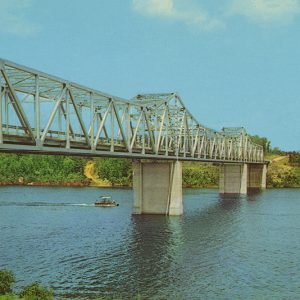calsfoundation@cals.org
Greers Ferry (Cleburne County)
| Latitude and Longitude: | 35º34’37″N 092º10’39″W |
| Elevation: | 604 feet |
| Area: | 7.22 square miles (2020 Census) |
| Population: | 821 (2020 Census) |
| Incorporation Date: | July 31, 1968 |
Historical Population as per the U.S. Census:
|
1810 |
1820 |
1830 |
1840 |
1850 |
1860 |
1870 |
1880 |
1890 |
1900 |
|
– |
– |
– |
– |
– |
– |
– |
– |
– |
– |
|
1910 |
1920 |
1930 |
1940 |
1950 |
1960 |
1970 |
1980 |
1990 |
2000 |
|
– |
– |
– |
– |
– |
– |
389 |
558 |
724 |
930 |
|
2010 |
2020 |
|
|
|
|
|
|
|
|
|
891 |
821 |
|
|
|
|
|
|
|
|
Greers Ferry, established and incorporated in 1968, quickly grew to become the second-largest city in Cleburne County. Named for the dam and lake that were constructed between 1959 and 1964, the community was created by some of the displaced citizens of older towns and settlements of the area. It exists in the twenty-first century primarily as a center of tourist activity.
Thomas C. Stark was the first settler to arrive in the area, establishing his homestead in the 1850s. Jess Pillam operated a store for settlers in the area, and, eventually, four tiny farming communities arose in the wooded area along the Little Red River in Cleburne County. Evening Shade, Post Oak, and Lone Pine each had one-room schoolhouses, and Stark had a post office that was opened on January 31, 1899, but closed on June 30, 1917. Post Oak also had a store, and Evening Shade had a Baptist church. Residents of the area received their mail at the Shiloh (Cleburne County) post office. In 1946, the scattered school districts of the area were consolidated into the West Side School District.
Frequent flooding of the Little Red River and other tributaries of the White River prompted a plan for dams that also would provide hydroelectric power and create recreational lakes. Construction began on Greers Ferry Dam in 1959, and people began relocating from the areas that would be permanently flooded when the dam was completed. Some left the area entirely, and others moved to larger cities such as Heber Springs (Cleburne County), but several families chose to remain as close as possible to their original homes. The new city, incorporated in 1968, was built on the north shore of Greers Ferry Lake—stretching from the Edgemont Bridge to the Narrows Bridge and extending from the Devil’s Fork recreational area south to the Shiloh recreational area. Incorporation of the city also made a water and sewer system possible for the residents who chose to remain in the area. Restaurants, banks, grocery stores, and other businesses were quickly built, as were three churches (two Baptist and one Methodist). By 1980, Greers Ferry had a population of 558, making it the second-largest community in the county.
In the early 1970s, a choral group from Texas, formerly known as the Dan Blocker Singers, had changed its name to “The Group” and relocated to Arkansas after failing to achieve recording success in California. After business failures in Russellville (Pope County) and at Mount Magazine, they opened a dinner theater in Greers Ferry in 1972. The Group was a communal organization that rejected abuse of drugs and alcohol and stressed hard work, cleanliness, respect for family, and involvement in the larger community. The first season of their business, the Snug Harbor Dinner Theater, was successful, and they opened a meat market in Greers Ferry; leased and operated motels; and started a weekly newspaper, which they called the Arkansas Sun. Fifty-two members of the commune registered as voters, prompting fears among Greers Ferry residents that the Group had plans to take over the city, or perhaps even the entire county. The Group began to receive bomb threats, and their property was vandalized. Before sunrise on August 25, 1973, a mob attacked the residences of the Group, screaming insults, breaking windows, damaging cars, and firing guns into the air. Although they had hunting rifles, no members of the Group returned fire, and no one was harmed during the incident. Six weeks later, the Group purchased four houses in Little Rock (Pulaski County) and left Greers Ferry.
The population of Greers Ferry as of the 2010 census is 891. West Side Elementary School and West Side High School have a total enrollment of 512 students. The city continues to be best known for recreational opportunities on the lake, including boating and fishing.
For additional information:
Berry, Evalena. Time and the River: A Centennial History of Cleburne County. Little Rock: Rose Publishing Company, 1982.
Greers Ferry Area Chamber of Commerce. http://www.greersferry.com/ (accessed June 4, 2022).
Steven Teske
CALS Encyclopedia of Arkansas
 Cleburne County Map
Cleburne County Map  Higden Bridge
Higden Bridge 



Comments
No comments on this entry yet.